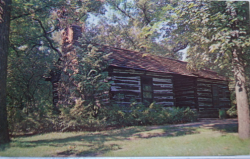Encyclopedia Dubuque
"Encyclopedia Dubuque is the online authority for all things Dubuque, written by the people who know the city best.”
Marshall Cohen—researcher and producer, CNN
Affiliated with the Local History Network of the State Historical Society of Iowa, and the Iowa Museum Association.
LOG CABIN: Difference between revisions
No edit summary |
No edit summary |
||
| Line 3: | Line 3: | ||
The cabin was built, according to best records, by a miner believed married to a daughter of Chief Blackhawk. A barber, Samuel Ellmer, later lived in the cabin and used his mastery of ventriloquism to convince Native Americans in the area that he had magical powers. The building, therefore, became a place of shelter for whites who knew they were safe from attack. It is also believed the priest [[MAZZUCHELLI, Samuel|Samuel MAZZUCHELLI]] said Mass at regular times at the cabin. | The cabin was built, according to best records, by a miner believed married to a daughter of Chief Blackhawk. A barber, Samuel Ellmer, later lived in the cabin and used his mastery of ventriloquism to convince Native Americans in the area that he had magical powers. The building, therefore, became a place of shelter for whites who knew they were safe from attack. It is also believed the priest [[MAZZUCHELLI, Samuel|Samuel MAZZUCHELLI]] said Mass at regular times at the cabin. | ||
In 1834 William Newman purchased the cabin which was used as the site of the wedding of an apprentice blacksmith, [[COOPER, Augustine | In 1834 William Newman purchased the cabin which was used as the site of the wedding of an apprentice blacksmith, [[COOPER, Austin Augustine|Austin Augustine COOPER]], and Newman's niece. [[BRIGGS, Ansel|Ansel BRIGGS]], on his way to becoming governor of Iowa, spoke at the cabin in 1846. | ||
[[Image:logcabinf.png|left|thumb|250px|Postcard of the cabin in Eagle Point Park.]] | [[Image:logcabinf.png|left|thumb|250px|Postcard of the cabin in Eagle Point Park.]] | ||
Revision as of 16:38, 14 April 2015
LOG CABIN. (Louis Arrandeaux Log House) Now located at the HAM HOUSE Museum, the cabin is believed to be the oldest building in Iowa. Constructed in 1827, the cabin stood at Second and Locust STREETS and was about to be torn down when discovered in 1915 by Frederick Ezekiel BISSELL.
The cabin was built, according to best records, by a miner believed married to a daughter of Chief Blackhawk. A barber, Samuel Ellmer, later lived in the cabin and used his mastery of ventriloquism to convince Native Americans in the area that he had magical powers. The building, therefore, became a place of shelter for whites who knew they were safe from attack. It is also believed the priest Samuel MAZZUCHELLI said Mass at regular times at the cabin.
In 1834 William Newman purchased the cabin which was used as the site of the wedding of an apprentice blacksmith, Austin Augustine COOPER, and Newman's niece. Ansel BRIGGS, on his way to becoming governor of Iowa, spoke at the cabin in 1846.
Clapboards painted white were eventually nailed to the cabin and disguised it until 1915. The building was moved to EAGLE POINT PARK, rebuilt and used as a park shelter. In 1957 it was recognized by the Dubuque Chapter of the Daughters of the American Revolution who marked it with a bronze plaque. The building was moved to the grounds of the Ham House in 1967. (Photo Courtesy: http://dubuque-tour.tripod.com)



